



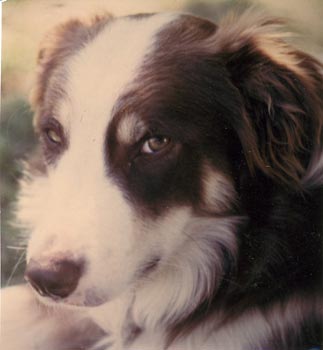
![]()
WOOLGATHER MOSS
NASDS 44344
1984-1999
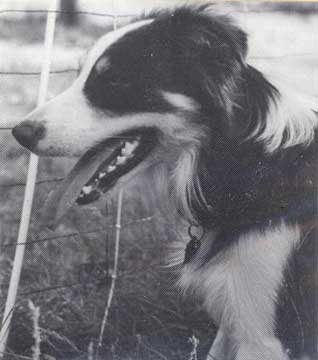
 Right, Moss, at 9 years old. (Photo by Tony Esposito.)
Right, Moss, at 9 years old. (Photo by Tony Esposito.)
Moss was supposed to be my dream dog, and when he was born he seemed to fulfill all my
dreams. He was a red tricolor, large, with a beautiful rough coat, and more laid back
than his siblings. When he was young, Iris Combe, a British show breeder of Border Collies,
was visiting us, and said that she thought he was gorgeous, and could be a show dog. He
learned how to herd young as he was born on our farm, and was very good at it. I was also
training him to track, which he seemed to like and was good at, and he was willing to be
harnessed and to pull a small cart. Furthermore, Moss was very affectionate, and unlike
his dam and sire, he loved being petted and hugged. We used to walk our dogs in a town
recreation area, that contained horse trails and a jumping course, and whenever we came
upon one of the horse jumps, we would encourage all the dogs to jump over them. Moss was
the only one who did eagerly, willingly, gracefully and easily.
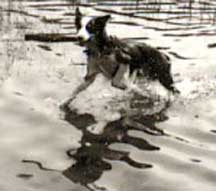
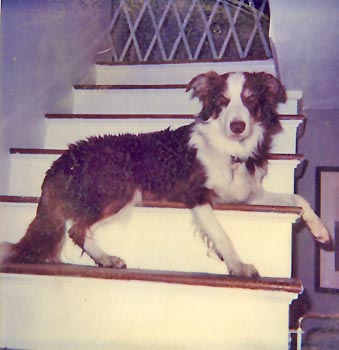 Left and right, Moss a little younger than a year old.
Left and right, Moss a little younger than a year old.
One day, when Moss was two and a half, I was working in the house, and all the dogs were
lying about. Moss was in the dining room, sleeping in a patch of sunlight. He looked
golden in the sun, and I remember thinking "my golden boy". Suddenly, he began to have a
seizure. One of my other dogs, Ettrick Linn, had epilepsy, but rarely had seizures, and
when she did they were of the type commonly referred to as "petit mal" or partial/focal
seizures--fully conscious, with just the lower part of her body affected. I had never seen
a "grand mal" or tonic-clonic seizure before. Moss was unconscious, lying on his side,
and "paddling" with his feet. His whole boy twitched, and he made the most awful grimaces
with his face. I panicked, and called the vet that we were currently using. He told me not
to worry, but just bring Moss in to see him later. Thereafter, I went through several vets
before finding one that I felt was actually competent to treat him, and we got his
seizures under some control.
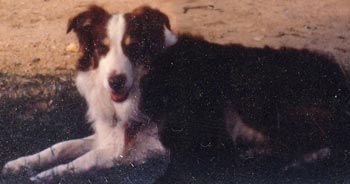 Phenobarbital worked for a while, but not for very long. Moss had frequent cluster
seizures, and he was becoming ataxic from the medication. Eventually we went to a
neurologist, who put him on potassium bromide and phenobarbital, but we had to keep
increasing the dosage. I started to keep a chart of all his seizures, hoping to find some
pattern, but in that I was to be disappointed. There WAS no pattern. Sometimes he would go
for months without a seizure, and then have several clusters three or four days in a row.
A cluster seizure is when the dog goes into another seizure soon after coming out of the
previous one. Then he might go for weeks without any seizure, and then have them again.
There wasn't even one period in his entire life where he had two periods of on or off
seizures that could have been considered alike. The only thing we could count on was that
he always had his seizures while at rest, and even that was not a completely invariable,
because once, when we were on a walk in the woods, he had one. Furthermore, he was
becoming more and more ataxic (which is defined as an inability to coordinate voluntary
muscular movements, a common side effect of anti-seizure medications which can cause
weakness and/or loss of control of the hind legs). He fell down, which he did frequently,
and had to be helped up. He could no longer do any of the things he used to do. He
couldn't herd, he couldn't jump, he couldn't pull a cart. And he was hungry all the time
from the medication so that he gained a lot of weight. Once, he had 4 cluster seizures in
a row, and it took more than 24 hours to come out of the "post ictal" stage, that time
right after a seizure where the dog staggers around bumping into things as if he were
blind, and seems totally disconnected from his environment. I took him with me in the car
that day to run some errands, and he acted like he had never been in a car before. It was
very scary. Through all of this, he remained a sweet, loving dog, though he became very
shy and would hide behind me if a stranger came along or at the vet's. Because I was with
him all the time and felt he couldn't be left alone, we had a very strong bond the like of
which I've never had with another dog.
Phenobarbital worked for a while, but not for very long. Moss had frequent cluster
seizures, and he was becoming ataxic from the medication. Eventually we went to a
neurologist, who put him on potassium bromide and phenobarbital, but we had to keep
increasing the dosage. I started to keep a chart of all his seizures, hoping to find some
pattern, but in that I was to be disappointed. There WAS no pattern. Sometimes he would go
for months without a seizure, and then have several clusters three or four days in a row.
A cluster seizure is when the dog goes into another seizure soon after coming out of the
previous one. Then he might go for weeks without any seizure, and then have them again.
There wasn't even one period in his entire life where he had two periods of on or off
seizures that could have been considered alike. The only thing we could count on was that
he always had his seizures while at rest, and even that was not a completely invariable,
because once, when we were on a walk in the woods, he had one. Furthermore, he was
becoming more and more ataxic (which is defined as an inability to coordinate voluntary
muscular movements, a common side effect of anti-seizure medications which can cause
weakness and/or loss of control of the hind legs). He fell down, which he did frequently,
and had to be helped up. He could no longer do any of the things he used to do. He
couldn't herd, he couldn't jump, he couldn't pull a cart. And he was hungry all the time
from the medication so that he gained a lot of weight. Once, he had 4 cluster seizures in
a row, and it took more than 24 hours to come out of the "post ictal" stage, that time
right after a seizure where the dog staggers around bumping into things as if he were
blind, and seems totally disconnected from his environment. I took him with me in the car
that day to run some errands, and he acted like he had never been in a car before. It was
very scary. Through all of this, he remained a sweet, loving dog, though he became very
shy and would hide behind me if a stranger came along or at the vet's. Because I was with
him all the time and felt he couldn't be left alone, we had a very strong bond the like of
which I've never had with another dog.
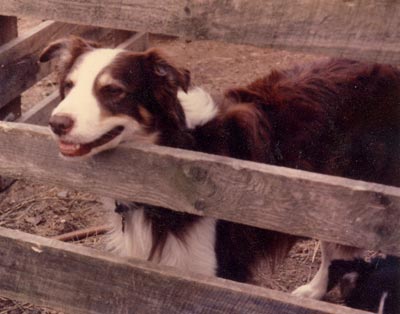 In 1991, when Moss was seven years old, we moved to the Ithaca, New York area and bought a
farm. We also started using Cornell University's School of Veterinary Medicine's Small
Animal Clinic for our vet care. While this was the best care Moss had ever received, he
got no better and his seizures were under no better control. Falling injured him, and he
dislocated one hip, but the vets at Cornell did not want to do surgery because of his
epilepsy and his age. The hip did not seem to bother him much, or slow him down. Once you
pointed him in a direction and started walking, he would follow, and he could move along
at a great clip. But he looked weird, and once, when I had him along to a training clinic
(because I couldn't leave him at home), people kept asking me what was wrong with him,
since he lurched around like a drunkard and always had a silly grin on his face. I
suspected that the seizures had damaged his brain to some extent. It certainly had an
effect on his nervous system, something you could see when the vet tested him for
reactions. A rubber hammer applied to his wrists and toes brought no discernible response.
In 1991, when Moss was seven years old, we moved to the Ithaca, New York area and bought a
farm. We also started using Cornell University's School of Veterinary Medicine's Small
Animal Clinic for our vet care. While this was the best care Moss had ever received, he
got no better and his seizures were under no better control. Falling injured him, and he
dislocated one hip, but the vets at Cornell did not want to do surgery because of his
epilepsy and his age. The hip did not seem to bother him much, or slow him down. Once you
pointed him in a direction and started walking, he would follow, and he could move along
at a great clip. But he looked weird, and once, when I had him along to a training clinic
(because I couldn't leave him at home), people kept asking me what was wrong with him,
since he lurched around like a drunkard and always had a silly grin on his face. I
suspected that the seizures had damaged his brain to some extent. It certainly had an
effect on his nervous system, something you could see when the vet tested him for
reactions. A rubber hammer applied to his wrists and toes brought no discernible response.
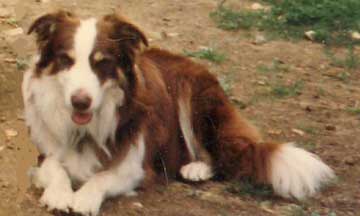 When Moss was 10 years old, he went into status epilepticus (a serious, life-threatening
situation in which the dog fails to come out of the seizure after 5 minutes or more), and
had to be hospitalized with intravenous Valium. The cycle was broken and I went to pick
him up, but on the way home in the car, he began to seize again, and I turned around and
returned to the hospital. I really thought that was going to be the end. I went to the vet
we were seeing at the time at Cornell, and asked her what I should do. She told me that
there was nothing else they could do for Moss. His medication could not be increased as it
was already at the highest tolerable levels. Then she told me that, while she couldn't
prescribe it herself because she had no experience with it, she had read that in humans
with epilepsy, vitamin E sometimes helped. I was desperate, and immediately put Moss on
400 i.u.s of vitamin E twice a day, and here is the amazing thing: he NEVER had another
seizure in his life--never! He lived 4 more years and we began backing him off the seizure
medication. By the time he died, at 14 1/2, from liver cancer, no doubt caused by years of
being on high doses phenobarbital and potassium bromide, he was almost completely off his
medications, and still not having seizures.
When Moss was 10 years old, he went into status epilepticus (a serious, life-threatening
situation in which the dog fails to come out of the seizure after 5 minutes or more), and
had to be hospitalized with intravenous Valium. The cycle was broken and I went to pick
him up, but on the way home in the car, he began to seize again, and I turned around and
returned to the hospital. I really thought that was going to be the end. I went to the vet
we were seeing at the time at Cornell, and asked her what I should do. She told me that
there was nothing else they could do for Moss. His medication could not be increased as it
was already at the highest tolerable levels. Then she told me that, while she couldn't
prescribe it herself because she had no experience with it, she had read that in humans
with epilepsy, vitamin E sometimes helped. I was desperate, and immediately put Moss on
400 i.u.s of vitamin E twice a day, and here is the amazing thing: he NEVER had another
seizure in his life--never! He lived 4 more years and we began backing him off the seizure
medication. By the time he died, at 14 1/2, from liver cancer, no doubt caused by years of
being on high doses phenobarbital and potassium bromide, he was almost completely off his
medications, and still not having seizures.
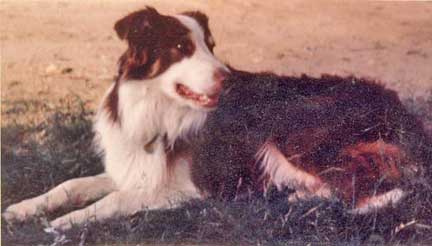 Now I want to tell you about epilepsy in Border Collies. When Moss started having seizures,
I contacted the breeders of his dam and sire, Jute and Willy. Willy's breeder gave me the
usual rhetoric on the subject: "It isn't in MY line, and I never heard of any other dog I
bred having it." Jute's breeders were very forthcoming. They told me that her dam had
epilepsy, but they thought it was because she had run headlong into a piece of farm
machinery and knocked herself unconscious. They gave me the names and phone numbers of all
the people who had bought puppies from them from three breedings of Jute's dam and sire. I
tried to contact all these people and was able to reach owners of 15 dogs--these were Jute's
littermates, or siblings from two other breedings, and their offspring. Out of the 15 dogs,
6 had epilepsy--that's 40%. Furthermore, I began to collect pedigrees of other Border
Collies with epilepsy, and found that there were many more of them that went back to the
same lines as Jute's dam. When we bred Willy and Jute, we got 5 puppies, including Moss.
One of the pups was sold to someone who was very active in obedience, and that dog did so
well that she was bred to the famous dog of a very well-known obedience breeder. When I
was collecting pedigrees of epileptic dogs, I heard from several people who had pups with
epilepsy from that breeding and further breeding down the line. While my research was
probably not scientific and probably not at all conclusive, I'm convinced that epilepsy in
Border Collies is hereditary. I mean, 40% in three litters from the same dam and sire? And more
pups with epilepsy in the subsequent generations? Shortly thereafter, the dog genome
project started collecting DNA from epileptic dogs of various breeds including the Border
Collie, but by then Willy, Jute, and Moss and all of his siblings were gone, as were all
the other dogs in my "study". But I have hope that in the future there will be a simple
genetic test for epilepsy, so that more epileptic dogs are not bred to break the hearts of
their owners.
Now I want to tell you about epilepsy in Border Collies. When Moss started having seizures,
I contacted the breeders of his dam and sire, Jute and Willy. Willy's breeder gave me the
usual rhetoric on the subject: "It isn't in MY line, and I never heard of any other dog I
bred having it." Jute's breeders were very forthcoming. They told me that her dam had
epilepsy, but they thought it was because she had run headlong into a piece of farm
machinery and knocked herself unconscious. They gave me the names and phone numbers of all
the people who had bought puppies from them from three breedings of Jute's dam and sire. I
tried to contact all these people and was able to reach owners of 15 dogs--these were Jute's
littermates, or siblings from two other breedings, and their offspring. Out of the 15 dogs,
6 had epilepsy--that's 40%. Furthermore, I began to collect pedigrees of other Border
Collies with epilepsy, and found that there were many more of them that went back to the
same lines as Jute's dam. When we bred Willy and Jute, we got 5 puppies, including Moss.
One of the pups was sold to someone who was very active in obedience, and that dog did so
well that she was bred to the famous dog of a very well-known obedience breeder. When I
was collecting pedigrees of epileptic dogs, I heard from several people who had pups with
epilepsy from that breeding and further breeding down the line. While my research was
probably not scientific and probably not at all conclusive, I'm convinced that epilepsy in
Border Collies is hereditary. I mean, 40% in three litters from the same dam and sire? And more
pups with epilepsy in the subsequent generations? Shortly thereafter, the dog genome
project started collecting DNA from epileptic dogs of various breeds including the Border
Collie, but by then Willy, Jute, and Moss and all of his siblings were gone, as were all
the other dogs in my "study". But I have hope that in the future there will be a simple
genetic test for epilepsy, so that more epileptic dogs are not bred to break the hearts of
their owners.
For more information on canine epilepsy, visit the Canine Epilepsy Network at
http://www.canine-epilepsy.net/
and the Epi Guardian Angels at
http://www.canine-epilepsy-guardian-angels.com/default.htm
 RETURN TO THE WOOLGATHER FARM HOME PAGE
RETURN TO THE WOOLGATHER FARM HOME PAGE
THE OTHER WEB PAGES WE MAINTAIN
These web pages are copyright ©2013
and maintained by webmeistress Carole Presberg
with technical help from webwizard David Presberg
ALL RIGHTS RESERVED
If you are interested in using ANY material on this website, you MUST first ask for permission.